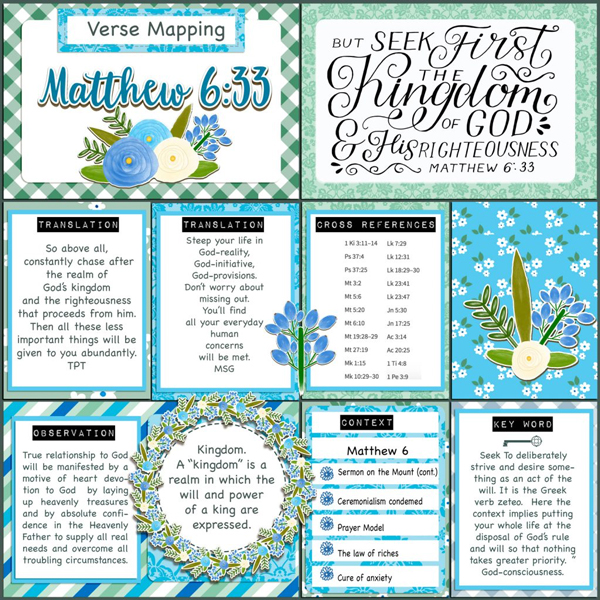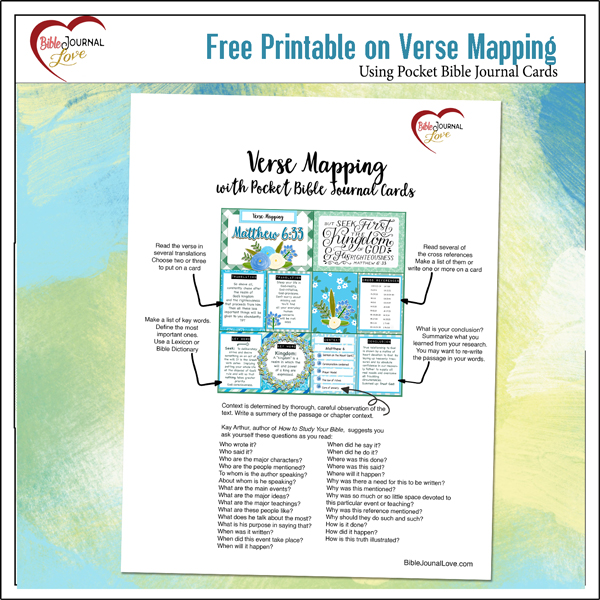For Bible study, verse mapping is a game changer. It's all there. It isn't simply about reading. It's learning everything you can about God and how he wants to speak to you through his word by researching everything you can in a verse. In summary? It's an exceptional research project.
Verse mapping will motivate you to go deeper into God's word than you've ever done before. When you verse map, the Holy Spirit is your teacher and partner; it's not what you bring to the table that qualifies you, but who you are, and no matter where you start, he'll make sure you learn.
Visual Chunks of Information
I have been using Bible Key Worksheets and the Inductive Bible Study Method for over twenty years. Verse mapping is very similar. I've combined these approaches with Becky Higgins' Project Life ideas to create Pocket Bible Journal Cards.

Verse Mapping Labels
Verse Mapping is a method of studying the Bible in a way that unpacks the scriptures using word origins, context, definitions, and prayer to help you find deeper meaning in God’s word and apply it to your life. You can use pocket cards for verse mapping, focusing on a theme, Bible book, chapter, or passage.
Our brains think in unique and logarithmic ways. Chunking refers to the strategy of breaking down information into bite-sized pieces so the brain can more easily digest new information. Working with a Bible passage is a chunk of information about the theme.
Add Verse Map to a Treasure Journal

 Created with these Treasure Journal Pages
Created with these Treasure Journal Pages
Our brain can hold a limited amount of information at one time. Each piece of information is best studied through a structured process of learning that assimilates that chunk of information. "Our short-term memory is on average only capable of storing seven items of information, and chunking can help us use this storage space more effectively." (Glass, A.L. and Holyoak, K.J.)
"By chunking information, the author improves the reader’s comprehension and ability to access and retrieve the information."(Robert Horn)
Free Verse Mapping Printable
Verse Mapping: Like Infographics
An infographic is a collection of imagery, charts, and minimal text that gives an easy-to-understand overview of a topic. Illustrations are powerful. Business people know that infographics are a powerful method to educate someone in an efficient amount of time.

Well-created infographics are thirty times more likely to be read than any text, and they have a clear goal. Bible journaling is structured similarly to the way our brains function by allowing associations and links to be recorded and reinforced. While creating a page or margin, ideas and thoughts are turned into something visible and structured.
Planning and creating a Bible journal page enhances learning, promotes creative thinking, aids memory skills and recall while enlisting the full power of both sides of the brain.
"Visual input creates the strongest recall value of all senses, and also allows the widest spectrum of levels-of-processing modifiers. It is also one of the most widely studied. Within visual studies, pictures have been shown to have a greater recall value than words—the picture superiority effect." (Craik, FIM; Lockhart RS)
Mapping a Bible Era



Verse Mapping a Verse
- TRANSLATIONS: Read in several translations. List two or three that speak to you, on cards.
- KEY WORDS: Make a list of key words. Define the most important ones on cards. Use a Lexicon or Bible dictionary.
- CROSS REFERENCES Read several of the cross references (related verses). Make a list of them or write one or more on a card. You can always add an extra page if you need more cards.
- CONTEXT: Context is determined by thorough, careful observation of the text. Write a summary of the passage or chapter context.
- APPLICATION OR CONCLUSION: What is your conclusion? How can you use what you learned? Summarize what you learned from your research. You may want to re-write the passage in your own words.


























